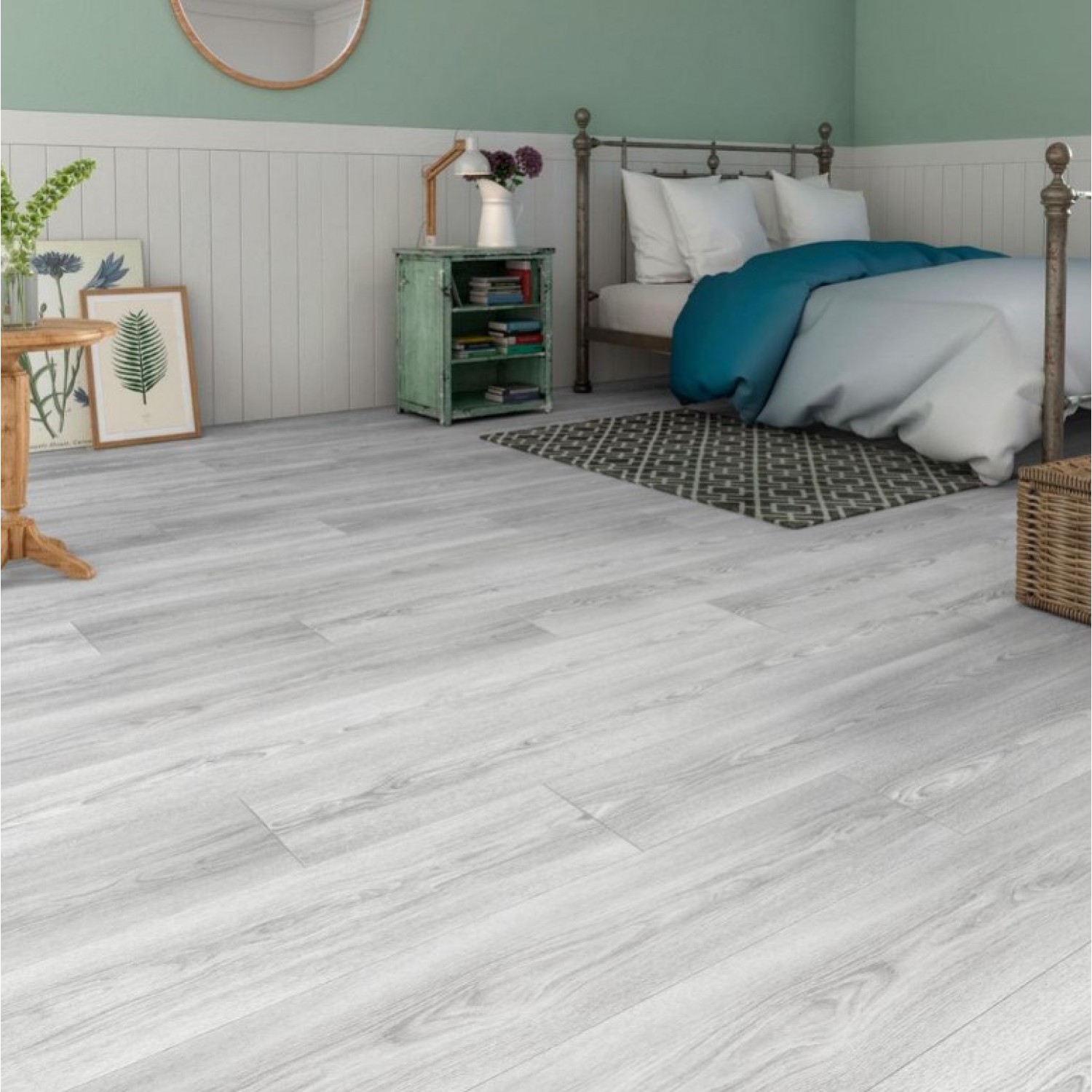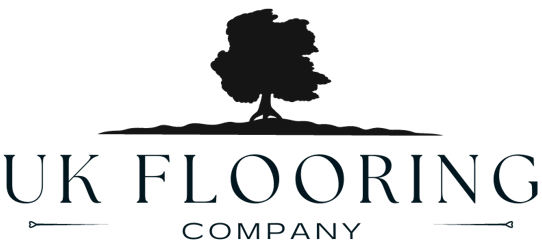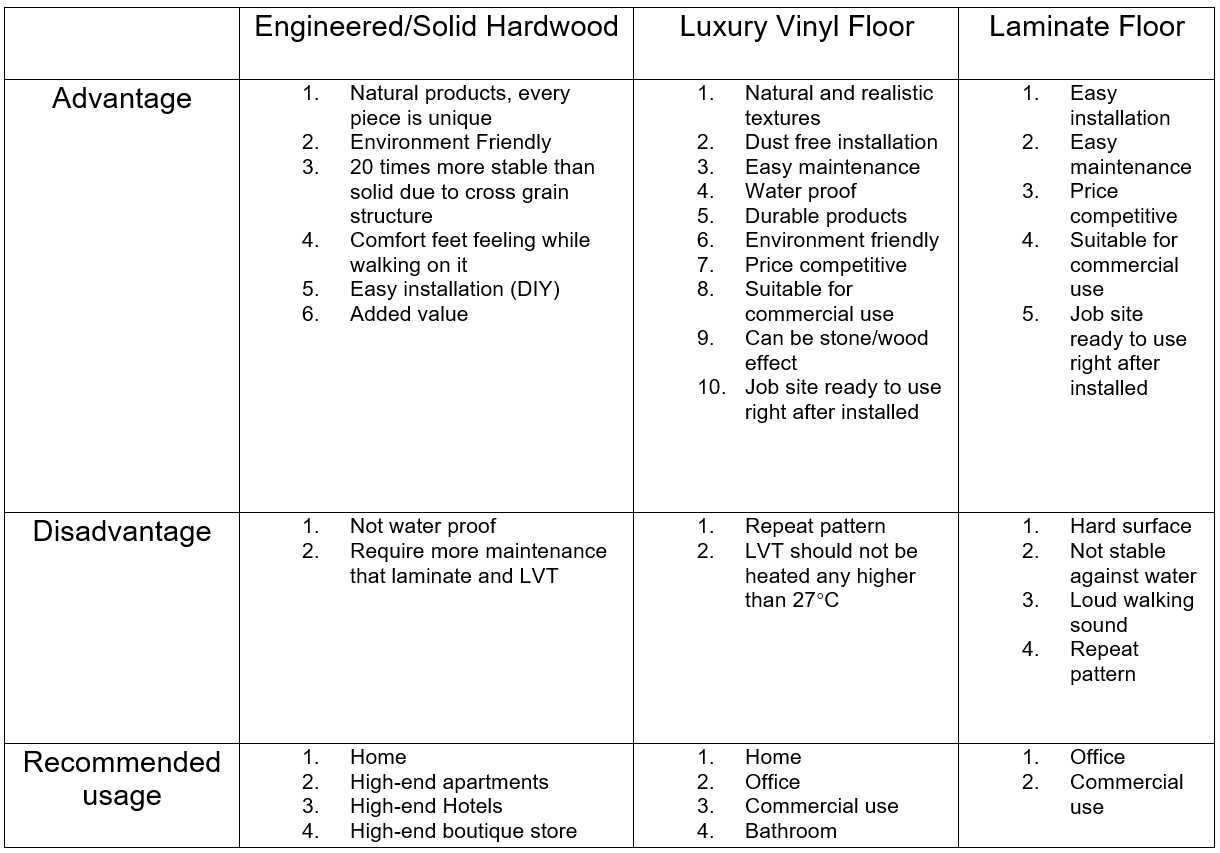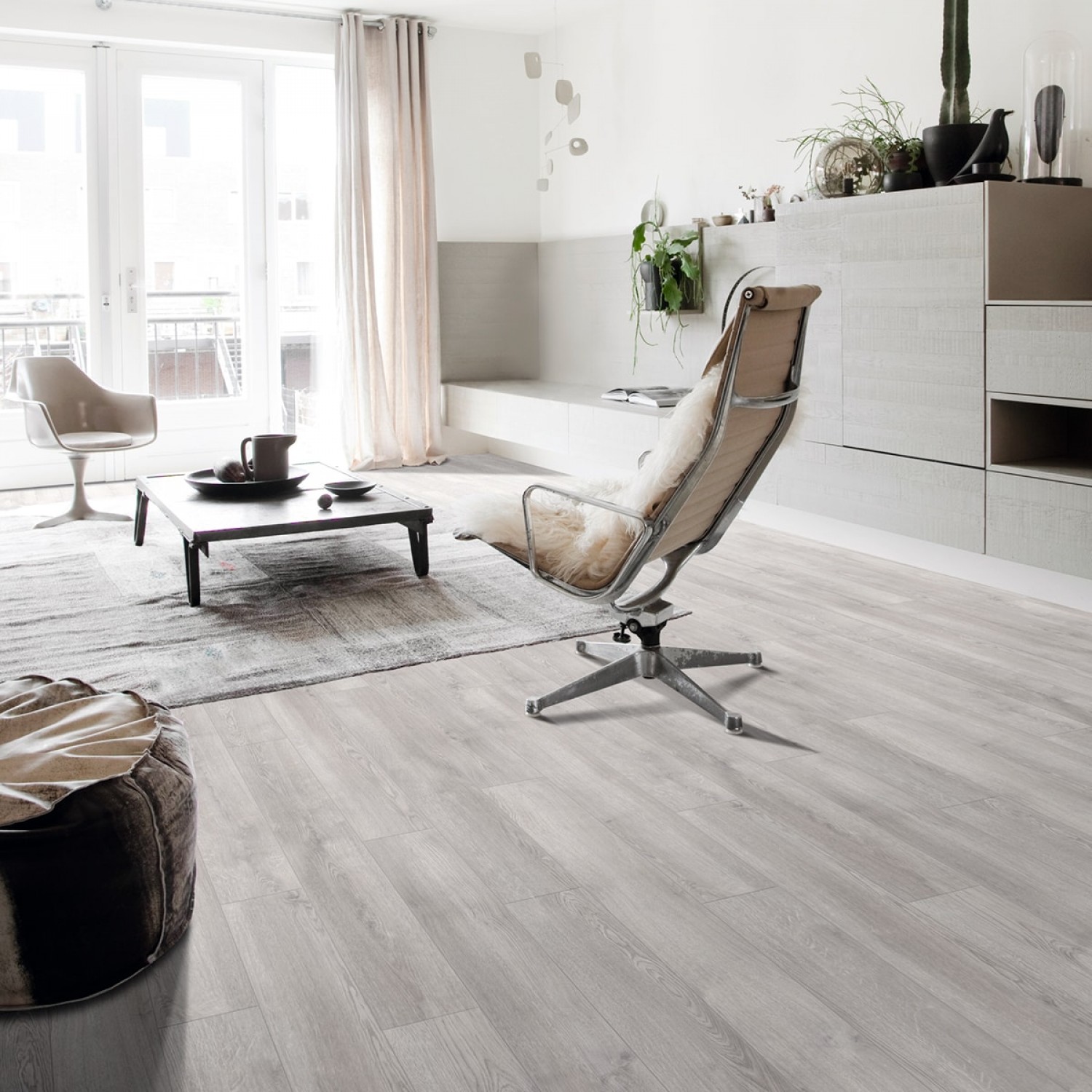5 Different Types Of Flooring Materials To Consider For Your Home – The Pros And Cons
-1920x600w.jpg)
02 Dec
11 Comment(s)
13056 View(s)
5 different types of flooring materials to consider for your home– the pros and cons
The pros and cons When it comes to hardwood flooring, many homeowners only think of solid wood and engineered wood. However, there are other manufactured woods, such as Luxury Vinyl Tiles that are fashioned to simulate the look and feel of hardwood.
Hardwood flooring is a beautiful but big investment. Thankfully there are other options that can give you the look of hardwood. We will break down the differences of each Engineered/Solid hardwood, LVT, Laminate so you can make the best decision for your home.
1.Solid WOOD FLOORING
Super popular in homes everywhere not only because wooden flooring like timber is gorgeous and suits many a different interior design scheme – be that more polished and contemporary and suits many a different interior design scheme – be that more polished and contemporary or rustic farmhouse – with varying grains, tones and finishes, but also because hardwood is very durable and resilient when treated and cared for properly. Timber is usually lacquered or oiled, very durable and resilient when treated and cared for properly. Timber is usually lacquered or oiled, depending on the look you prefer.
Advantages: Solid wood flooring is versatile in its look and can complement all types of interiors. It's long-lasting and will withstand up to five refinishes to remove surface scratches. Andrew Barker, Founder & CEO of HomeownerCosts adds that Real estate experts say that hardwood flooring could increase the resale value of your home as it's such a sought-after feature for many.
Disadvantages: It's the cost and the upkeep that comes with Solid wood flooring which can put it at a disadvantage as you will usually need a professional's help to get a good finish, unless you're up for some fairly expert DIY. Prices vary according to the thickness of the decorative wood veneer and quality of the core. Barker notes also that 'When exposed to moisture for a long time it can warp making them not fit for bathrooms or laundry rooms.' So you may not be able to install Solid wood flooring everywhere, especially not in a shower...
2. ENGINEERED WOOD FLOORING TYPES
Engineered wood floors feature a real wood veneer over a middle core of heat-formed wood and a base-supporting layer (used where shrinkage might be a problem). The stability of engineered flooring makes it a perfect choice over underfloor heating if the guidelines are followed, plus it is easier to lay than solid wood flooring.
Advantages: Because of how they are made, engineered wood planks are usually more dimensionally stable and less likely to expand or contract with temperature changes or fluctuations in humidity.
Disadvantages: Unlike Solid wood flooring, it won't take to refinishing so well because of the thinner top layer.
3. LAMINATE FLOORING
Laminate flooring is made from layers of high density fiberboard with a photographic image (of timber, tile etc) laminated to the surface below a tough, wear-resistant coating.

Advantages: Its advantages are its price, anti-scratching properties and ease of installation. Laminate is a great choice for a busy household in all areas that are not exposed to heavy moisture (so avoid using in a bathroom).
Disadvantages: It depends on the manufacturer but laminate flooring types can feel cold and hard underfoot. If laid badly, it may also be noisy and clunky.
Top tips: Saul notes that you should avoid really cheap faux wood laminate flooring as this will only be reflected in the quality. Generally speaking however, 'it is easy to maintain and it is durable.' Saul also recommends laminate flooring for basement locations.
4. LUXURY VINLY TILE
If you want the benefits of vinyl without the worry of it looking cheap or not lasting very long, there's always the luxury vinyl option. When luxury vinyl flooring options entered the picture it was a game changer. Homeowners got the beauty of hardwoods without the upkeep. LVT is not your grandmother’s vinyl flooring – you know the flooring that yellows over time and feels like plastic? LVT rather than coming in sheets, comes in planks.
Advantages: These interlocking planks are engineered to include the look and feel of hardwoods in a material that is much more durable. LVT is typically more cost effective than hardwood and can be used throughout the home – including in those wet areas as many LVT brands are waterproof. Making it a possibility for bathrooms and kitchen flooring options too. Look out for luxury vinyl tiles too like the above from UK Flooring Company.
Disadvantages: It's a little more expensive and not the real deal.
WHAT IS THE LEAST EXPENSIVE FLOORING?
If your main priority is finding the cheapest types of flooring for your home, look into vinyl. We'd recommend checking the prices of any luxury vinyl options and maybe mixing and matching to help add more style but stay on budget too.
Showing 1 to 11 of 11 (1 Pages)

%20(1000%20×%20700%20px)%20(1000%20×%20650%20px)%20(1000%20×%20670%20px)-700x500w.png)
.jpg)

.jpg)

11 Comment(s)
It's fantastic that you mentioned that there is always the luxury vinyl option if you want the advantages of vinyl without having to worry about it appearing cheap or not lasting very long. Before the summer, my best friend is remodeling her entire home since she enjoys hosting dinner parties there for the whole gang. She asked me, however, what sort of flooring I would recommend installing, so I will send her this. Vinyl floors are lovely, in my opinion, so I hope she will give them some thought.
I'm renovating our family vacation house before my cousins come to visit during the summer holidays, so I was thinking of replacing the floorboards as well while I'm at it. I'm grateful you recommended that we consider luxury vinyl tiles for our new flooring since we can enjoy the beauty of hardwoods without worrying about the upkeep. I'll keep this in mind while I look for a flooring company to contact for the new installation soon.
Before my cousins arrive during the summer vacation, I'm remodeling our family vacation home, therefore I was considering redoing the flooring as well. I appreciate you suggesting luxury vinyl tiles for our new flooring so we can enjoy the beauty of hardwoods without having to worry about maintenance. I'll have this in mind when I search for a flooring business to get in touch with for the upcoming new installation, but right now I am leaning towards getting laminate vinyl flooring.
When you said that there was always the luxury vinyl option if you wanted the advantages of vinyl but didn't want to worry about it appearing cheap or not lasting very long, that drew my eye. Later this year, I'm building a restaurant, and I was considering employing concrete floor polishing for the establishment due to the way it looks. While looking for a flooring store to speak with about my other alternatives, I'll make sure to keep this in mind.
Blog wonder what a wonderful article i became a fan, i want more texts like this one i like it here
The constant battle against carpet stains, especially with a toddler and a clumsy dog in the house, has become a daily struggle. The idea of a hardwood flooring installation is starting to sound like a sanity-saving solution to easily wipe away the evidence of our everyday messes. You convinced me even more when you said that solid wood flooring has a timeless appearance that goes well with any kind of interior design. It can also be refinished up to five times to get rid of surface blemishes.
Informative read! This comprehensive guide explores the pros and cons of 5 different flooring materials, providing valuable insights for anyone contemplating a home upgrade. This is a must-read for homeowners seeking the perfect balance between aesthetics and functionality in their flooring choices.
My brother is searching for a few options to consider as he plans to replace his carpets. It's good that you said that it is an environmentally friendly option but also easy to maintain. I'll make sure to share this with him because I think it would be an excellent choice to try out. I'll look into vendors who can assist him in obtaining one; I appreciate you sharing!
Fantastic overview of flooring options! This article provides a concise breakdown of the pros and cons of five different types of flooring materials, making it easier for homeowners to weigh their options. Whether you're aiming for durability, aesthetics, or affordability, this guide helps you make an informed decision for your home. Great resource!"
Most impressive post! I have read so many blogs on health and fitness but this blog has amazing content
I am very pleased to discover this web page. I want to tell you thx for your effort in providing this amazing read! I certainly enjoyed it and I have you book-marked to follow new issues you post.
Leave a Comment